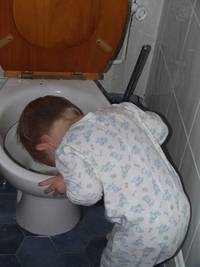 This Town May Soon Resort to Drinking Toilet Water Due to Drought
This Town May Soon Resort to Drinking Toilet Water Due to DroughtThis Texas Town May Soon Resort to Drinking Toilet Water Due to Drought
Lifestyle
Nation
Has Been Optimized
Wichita Falls, Tex., may very well become the next site of the growing “toilet to tap” movement.
The technology is technically called “water reclamation,” or more specifically “direct potable reuse.” According to city official Daniel Nix, there is actually not that much toilet water involved in the process.
“The vast majority of water that enters a wastewater plant did not come from a toilet," he says. "They come from sinks, and bathtubs, and washing machines and dishwashers."
The plan to treat the city’s sewage comes from being in the third year of an extreme drought. Mayor Glenn Barham says residents are already sacrificing to cut back on the city’s water usage.
“No outside irrigation whatsoever with potable water," he says. "Car washes are closed, for instance, one day a week. If you drain your pool to do maintenance, you're not allowed to fill it."
While the city has managed to cut down their water usage by one-third, it is estimated that the water supply will run out within two years. In response to this estimate, the city has built a 13-mile pipeline which connects the city’s wastewater plant directly to the plant where water is purified for drinking.
The city has begun an educational campaign to make the idea seem more appealing to its residents, mostly through science.
NPR reports that water in Wichita Falls is currently being treated and dumped into the Big Wichita River where it is cleaned naturally. The water is carried downstream where other cities will treat and eventually drink it.
Nix says the city plans to speed up the natural process within the plant.
“Rather than wait several weeks for ultraviolet radiation from the sun to disinfect or kill bacteria, we do it in the plant using chlorine. It takes a matter of minutes to do it instead of weeks."
The Orange County Water District (OCWD) in California leads the way in direct potable reuse in the U.S. While the rest of California is suffering from the same three-year-drought as Texas, CNN reports that the OCWD plant is expanding to provide 100 million gallons of water per day, which is enough for roughly one-third of the county’s population.
The water goes through a three-step treatment process – microfiltration, to filter out all of the solids, oils and bacteria; reverse osmosis, where it is pushed through a fine plastic membrane to filter out viruses and pharmaceuticals; and lastly the water is treated with UV light to remove any remaining organic compounds, before joining the main groundwater supply.
This technology could ease a global problem. The U.N. predicts that half of the world will face water scarcity by 2030. Singapore has already decreased its’ dependence on imported water by 30% using the same technology.
Is it safe though? Benedito Braga, President of the World Water Council tells CNN that residents have nothing to worry about from drinking purified wastewater.
"Standards are stricter because of the novelty of the technology and process," Braga says. "The quality from sewage is very good, as good or better than the tap water in any city in the developed world."
1
Video Piece:
Regular Piece Reported by Opposing Views 2 hours ago.


















